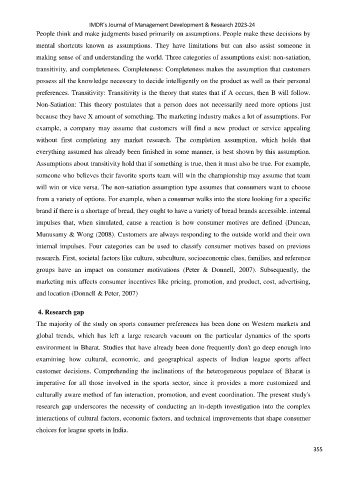Page 363 - IMDR JOURNAL 2023-24
P. 363
IMDR’s Journal of Management Development & Research 2023-24
People think and make judgments based primarily on assumptions. People make these decisions by
mental shortcuts known as assumptions. They have limitations but can also assist someone in
making sense of and understanding the world. Three categories of assumptions exist: non-satiation,
transitivity, and completeness. Completeness: Completeness makes the assumption that customers
possess all the knowledge necessary to decide intelligently on the product as well as their personal
preferences. Transitivity: Transitivity is the theory that states that if A occurs, then B will follow.
Non-Satiation: This theory postulates that a person does not necessarily need more options just
because they have X amount of something. The marketing industry makes a lot of assumptions. For
example, a company may assume that customers will find a new product or service appealing
without first completing any market research. The completion assumption, which holds that
everything assumed has already been finished in some manner, is best shown by this assumption.
Assumptions about transitivity hold that if something is true, then it must also be true. For example,
someone who believes their favorite sports team will win the championship may assume that team
will win or vice versa. The non-satiation assumption type assumes that consumers want to choose
from a variety of options. For example, when a consumer walks into the store looking for a specific
brand if there is a shortage of bread, they ought to have a variety of bread brands accessible. internal
impulses that, when simulated, cause a reaction is how consumer motives are defined (Duncan,
Munusamy & Wong (2008). Customers are always responding to the outside world and their own
internal impulses. Four categories can be used to classify consumer motives based on previous
research. First, societal factors like culture, subculture, socioeconomic class, families, and reference
groups have an impact on consumer motivations (Peter & Donnell, 2007). Subsequently, the
marketing mix affects consumer incentives like pricing, promotion, and product, cost, advertising,
and location (Donnell & Peter, 2007)
4. Research gap
The majority of the study on sports consumer preferences has been done on Western markets and
global trends, which has left a large research vacuum on the particular dynamics of the sports
environment in Bharat. Studies that have already been done frequently don't go deep enough into
examining how cultural, economic, and geographical aspects of Indian league sports affect
customer decisions. Comprehending the inclinations of the heterogeneous populace of Bharat is
imperative for all those involved in the sports sector, since it provides a more customized and
culturally aware method of fan interaction, promotion, and event coordination. The present study's
research gap underscores the necessity of conducting an in-depth investigation into the complex
interactions of cultural factors, economic factors, and technical improvements that shape consumer
choices for league sports in India.
355

